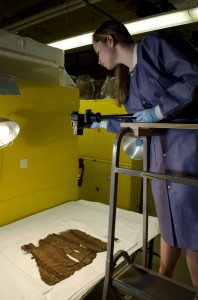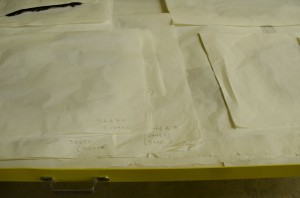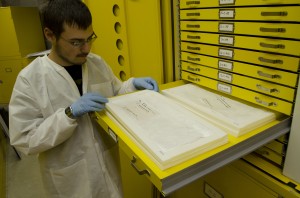Time is quickly passing, but we are making great strides and accomplishments in the IMLS grant-funded Pachacamac Survey Project! This one-year grant covers a detailed condition assessment, photography and rehousing of the archeological textiles and ceramics affiliated with Max Uhle’s 1896 excavation in Pachacamac, Peru. All these steps (and a few more) are going on simultaneously, keeping us on our toes with so much activity. Here’s a quick glimpse into two of the three steps (photography and housing) and our progress to date. Since I’m involved with the textile portion of the project, this update focuses on that aspect, though similar activities are being accomplished with the ceramics in this collection.
As of today, we have taken photographs of over 1000 textiles (approximately 5000 photographs)! Most of the large textiles in the collection had never been photographed, since they are unwieldy, huge (to say the least) and fragile.

Just getting them out of their former storage location was a major endeavor needing several people! A main component of the grant was to increase accessibility of the collection to researchers, while preserving them for generations to come. That being said, this goal is accomplished with both photography and housing. Having good digital photographs saves time for museum staff and researchers. It also reduces the handling of these fragile and often brittle archeological materials. Many questions can be answered by a quick peek at a photograph in the museum’s collection database. Additionally, a detailed photograph creates a current record of condition. Many of the photographs are already on-line for the public to view, so please take a look at them using the Penn Museum “Search the Collection” tab! Type in Pachacamac and drool!
Part of being a conservator involves the careful consideration of storage solutions based on the object’s needs, the institution’s storage situation and the use of the object (future handling). With these in mind, we try to minimize the physical and chemical deterioration of the object by choosing an appropriate storage solution. Some of the textiles were rehoused years ago into textile storage folders, but many still needed a permanent “home”. Since most of these archeological textiles had issues (brittle, fragmentary, thick, and/or unevenly layered), commonly used textile storage techniques could not be employed. An archival tray solution was developed, built on the previous housing campaigns size configurations, to give each piece proper support.

These trays can stack, fit into the drawers of their new storage location and do not crush the fragile textile. As of today, over 800 textiles have been rehoused! Museum staff and curators can now safely access the collection.


Check out these photos of the process taken over the past few months. A big THANK YOU to our wonderful interns and volunteers, without them we could not have accomplished so much in such a short amount of time! Stay tuned for more updates on the project and of course, Penn’s continued commitment to preservation!

